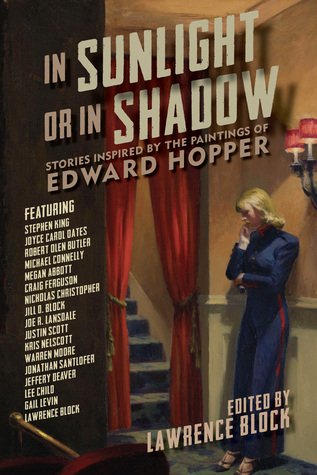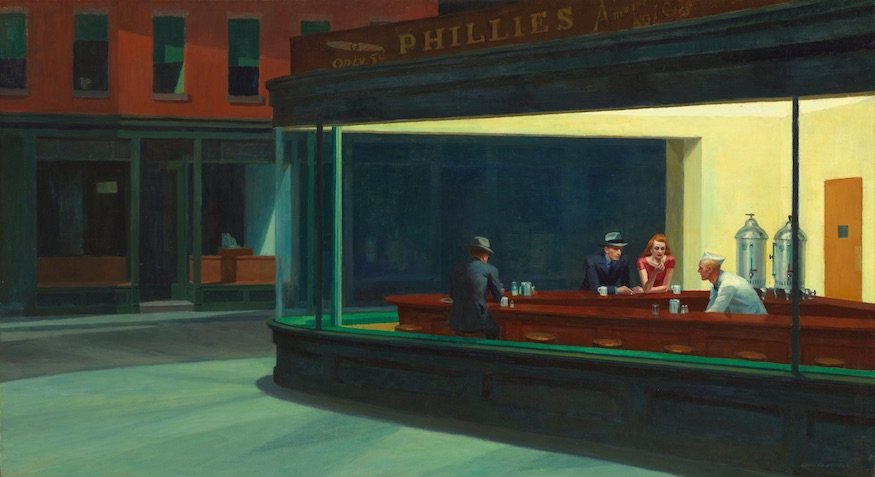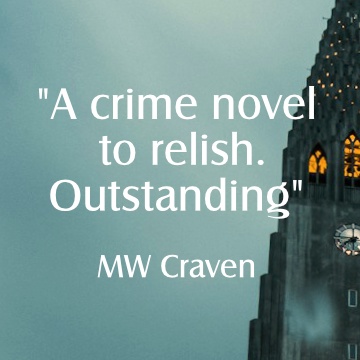 Edited by Lawrence Block — What an interesting concept for a crime short story anthology. In Sunlight or In Shadows includes 17 tales, each by a different author, and each inspired by a painting by Edward Hopper. The American realist’s work is tinged with a noir atmosphere – ideal creative grist for authors like Joyce Carol Oates, Robert Olen Butler, Michael Connelly, Megan Abbott, Craig Ferguson and Stephen King.
Edited by Lawrence Block — What an interesting concept for a crime short story anthology. In Sunlight or In Shadows includes 17 tales, each by a different author, and each inspired by a painting by Edward Hopper. The American realist’s work is tinged with a noir atmosphere – ideal creative grist for authors like Joyce Carol Oates, Robert Olen Butler, Michael Connelly, Megan Abbott, Craig Ferguson and Stephen King.
In his introduction, the book’s editor Lawrence Block points out Hopper’s concern with shape, light and colour rather than meaning or narrative. “The paintings don’t tell stories. What they do is suggest – powerfully, irresistibly – that there are stories within them, wanting to be told,” says Block.
And that is where the authors come in. They bring the narrative to Hopper’s scenes. Some write the paintings into the stories, while others use the paintings to provide backstory for their tales. Half the fun is seeing how each writer decides to use Hopper’s work to inform their own.
Megan Abbott’s Girlie Show opens the collection. It is a sinewy tale that reads like delicious pulp straight out Hopper’s time – the 1920s, 30s and 40s. The story follows a childless couple who are artists. The husband, after hearing a story from his buddy about how he’d seen a naked lady in a girlie show, starts demanding that his wife pose for a nude painting each night in the kitchen. The story cranks to a fever pitch and Abbott never lets up. The Hopper painting figures as a physical object in the story.
Lawrence Block’s daughter Jill Block contributes The Story of Caroline, about a middle-aged woman searching for a mother who gave her up for adoption at birth. The story alternates between a first person and omniscient narrative. Jill Block uses Hopper’s Summer Evening to provide a visual backstory for her tale, adding a lot to the narrative. Block’s story is an emotional wallop that leaves you right at the perfect dramatic moment.
Robert Olen Butler’s Soir Bleu is a strong noir piece in the collection, about the man beneath the clown mask in Hopper’s early painting of the same name. Lee Child writes a fun story of unreliability featuring a one-legged man wrapped up in the infamous World War II Manhattan Project and even names one of his characters Mr Hopper in homage.
Nicholas Christopher take Hopper’s enigmatic painting Rooms by the Sea, which has a door opening onto the ocean. He interprets it literally by weaving the image of the painting into the story. The result is a layered tale with a tinge of magical realism to it. Christopher’s story is well paced and it feels really substantial for a short story.
Michael Connelly gives us Harry Bosch in the Art Institute of Chicago in front of what is arguably Hopper’s most famous work, Nighthawks. Bosch is doing PI work and talks with a young lady he is trailing about the painting. The lone figure at the counter in Hopper’s painting is a point of contemplation for Bosch as he tries to understand himself as a PI.
The Music Room is Stephen King‘s contribution – a short, creepy tale about the Enderbys, a couple who go to desperate measures to survive the Great Depression. Former late night TV personality Craig Ferguson’s Taking Care of Business is a great story about a couple of old pot-smoking pals that is funny, poignant and highly enjoyable. You can’t help but smile when reading Ferguson’s story and it is a notable standout amongst the collection. Expert noir author Jonathan Santlofer brings Night Windows to the collection, a voyeuristic Hitchcockian tale that will have you tearing to the end to figure it out.
Some of the stories feel rushed, while others are a bit too long. Bringing such an eclectic group of writers together makes for a collection that is varied but at times lacks a cohesiveness which makes the pacing uneven. The writers who do best are those working closest to painter’s noir-like aesthetic. Santlofer, King, Connelly, Abbott, Jill Block, and Lawrence Block all write stories that really feel part of that world, and they are the most enjoyable.
Overall this is a great idea and a strong collection. This book is a must for Edward Hopper fans, and anyone interested in the intersection of visual art and fiction. People looking for a pure noir collection will get their itch scratched, for the most part, but might be a little disappointed by the stories that veer.
For another collection of themed short stories, try Sunshine Noir.
Pegasus
Print/Kindle/iBook
£10.44
CFL Rating: 4 Stars









